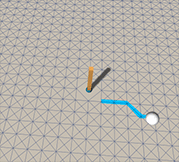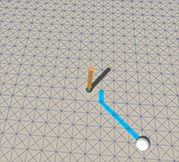Class RandomPath Extends ABPath
Finds a path in a random direction from the start node.
Terminates and returns when G >= length (passed to the constructor) + RandomPath.spread or when there are no more nodes left to search.
// Call a RandomPath call like this, assumes that a Seeker is attached to the GameObject
// The path will be returned when the path is over a specified length (or more accurately when the traversal cost is greater than a specified value).
// A score of 1000 is approximately equal to the cost of moving one world unit.
int theGScoreToStopAt = 50000;
// Create a path object
RandomPath path = RandomPath.Construct(transform.position, theGScoreToStopAt);
// Determines the variation in path length that is allowed
path.spread = 5000;
// Get the Seeker component which must be attached to this GameObject
Seeker seeker = GetComponent<Seeker>();
// Start the path and return the result to MyCompleteFunction (which is a function you have to define, the name can of course be changed)
seeker.StartPath(path, MyCompleteFunction);
A* Pro Feature:
This is an A* Pathfinding Project Pro feature only. This function/class/variable might not exist in the Free version of the A* Pathfinding Project or the functionality might be limited.
The Pro version can be bought here
Public Methods
Public Static Methods
Public Variables
An aim can be used to guide the pathfinder to not take totally random paths.
G score to stop searching at.
All G scores between searchLength and searchLength+spread are valid end points, a random one of them is chosen as the final point.
Inherited Public Members
Blocks until this path has been calculated and returned.
Returns if the node can be traversed.
Returns if the path can traverse a link between from and to and if to can be traversed itself.
Increase the reference count on this path by 1 (for pooling).
Current state of the path.
Construct a path with a start and end point.
Aborts the path because of an error.
Creates a fake path.
True for paths that want to search all nodes and not jump over nodes as optimizations.
Returns penalty for the given tag.
Total Length of the path.
Returns the cost of traversing the given node.
True if this path is done calculating.
Opens a connection between two nodes during the A* search.
Burst-compiled internal implementation of OpenCandidateConnection.
Open a connection to the temporary end node if necessary.
Returns the state of the path in the pathfinding pipeline.
Reduces the reference count on the path by 1 (pooling).
Copies the given settings into this path object.
Waits until this path has been calculated and returned.
Calculate partial path if the target node cannot be reached.
Callback to call when the path is complete.
Total cost of this path as used by the pathfinding algorithm.
How long it took to calculate this path in milliseconds.
Which graph tags are traversable.
End node of the path.
End point of the path.
Optional ending condition for the path.
If the path failed, this is true.
Additional info on why a path failed.
Determines which heuristic to use.
Scale of the heuristic values.
Immediate callback to call when the path is complete.
Constraint for how to search for nodes.
End Point exactly as in the path request.
Start Point exactly as in the path request.
ID of this path.
Number of nodes this path has searched.
Start node of the path.
Start point of the path.
Penalties for each tag.
Provides additional traversal information to a path request.
Holds the (possibly post-processed) path as a Vector3 list.
Private/Protected Members
Calculates the path until completed or until the time has passed targetTick.
Always called after the path has been calculated.
Returns a debug string for this path.
Writes text shared for all overrides of DebugString to the string builder.
Writes text shared for all overrides of DebugString to the string builder.
Applies a special case for grid nodes.
Called when the path enters the pool.
Prepares the path.
Prepares low level path variables for calculation.
Reset all values to their default values.
Calls callback to return the calculated path.
Traces the calculated path from the end node to the start.
Sets the start and end points.
List of zeroes to use as default tag penalties.
Currently chosen end node.
Target to use for H score calculation.
True if the Reset function has been called.
Determines if a search for an end node should be done.
Target to use for H score calculations.
The tag penalties that are actually used.
The G score of #maxGScoreNodeR.
The node with the highest G score which is still lower than searchLength.
Current best target for the partial path.
Data for the thread calculating this path.
Random number generator.

